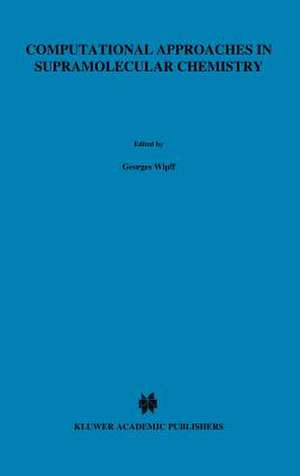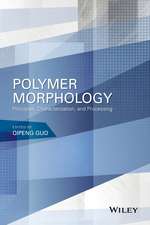Computational Approaches in Supramolecular Chemistry: Nato Science Series C:, cartea 426
Editat de G. Wipffen Limba Engleză Hardback – 31 mar 1994
| Toate formatele și edițiile | Preț | Express |
|---|---|---|
| Paperback (1) | 1827.98 lei 6-8 săpt. | |
| SPRINGER NETHERLANDS – 5 noi 2012 | 1827.98 lei 6-8 săpt. | |
| Hardback (1) | 1833.95 lei 6-8 săpt. | |
| SPRINGER NETHERLANDS – 31 mar 1994 | 1833.95 lei 6-8 săpt. |
Din seria Nato Science Series C:
- 24%
 Preț: 797.66 lei
Preț: 797.66 lei - 18%
 Preț: 957.62 lei
Preț: 957.62 lei - 18%
 Preț: 957.13 lei
Preț: 957.13 lei - 18%
 Preț: 1227.52 lei
Preț: 1227.52 lei -
 Preț: 396.40 lei
Preț: 396.40 lei -
 Preț: 403.75 lei
Preț: 403.75 lei - 18%
 Preț: 1239.37 lei
Preț: 1239.37 lei - 18%
 Preț: 1236.51 lei
Preț: 1236.51 lei - 18%
 Preț: 1231.78 lei
Preț: 1231.78 lei - 18%
 Preț: 1229.10 lei
Preț: 1229.10 lei - 18%
 Preț: 1835.21 lei
Preț: 1835.21 lei - 24%
 Preț: 1076.36 lei
Preț: 1076.36 lei -
 Preț: 390.46 lei
Preț: 390.46 lei -
 Preț: 369.63 lei
Preț: 369.63 lei - 18%
 Preț: 1232.41 lei
Preț: 1232.41 lei -
 Preț: 394.51 lei
Preț: 394.51 lei - 18%
 Preț: 1226.24 lei
Preț: 1226.24 lei - 18%
 Preț: 1845.80 lei
Preț: 1845.80 lei -
 Preț: 399.88 lei
Preț: 399.88 lei -
 Preț: 384.28 lei
Preț: 384.28 lei -
 Preț: 390.88 lei
Preț: 390.88 lei -
 Preț: 381.19 lei
Preț: 381.19 lei - 18%
 Preț: 1848.64 lei
Preț: 1848.64 lei - 18%
 Preț: 951.14 lei
Preț: 951.14 lei - 18%
 Preț: 1230.35 lei
Preț: 1230.35 lei - 18%
 Preț: 1236.51 lei
Preț: 1236.51 lei -
 Preț: 401.03 lei
Preț: 401.03 lei -
 Preț: 406.25 lei
Preț: 406.25 lei - 18%
 Preț: 1230.84 lei
Preț: 1230.84 lei -
 Preț: 418.34 lei
Preț: 418.34 lei - 18%
 Preț: 1223.74 lei
Preț: 1223.74 lei
Preț: 1833.95 lei
Preț vechi: 2236.53 lei
-18% Nou
Puncte Express: 2751
Preț estimativ în valută:
350.92€ • 367.38$ • 290.37£
350.92€ • 367.38$ • 290.37£
Carte tipărită la comandă
Livrare economică 05-19 aprilie
Preluare comenzi: 021 569.72.76
Specificații
ISBN-13: 9780792327677
ISBN-10: 0792327675
Pagini: 552
Ilustrații: XV, 531 p.
Dimensiuni: 155 x 235 x 35 mm
Greutate: 0.94 kg
Ediția:1994
Editura: SPRINGER NETHERLANDS
Colecția Springer
Seria Nato Science Series C:
Locul publicării:Dordrecht, Netherlands
ISBN-10: 0792327675
Pagini: 552
Ilustrații: XV, 531 p.
Dimensiuni: 155 x 235 x 35 mm
Greutate: 0.94 kg
Ediția:1994
Editura: SPRINGER NETHERLANDS
Colecția Springer
Seria Nato Science Series C:
Locul publicării:Dordrecht, Netherlands
Public țintă
ResearchCuprins
1 Water structure from computational chemistry.- 2 Ionic hydrogen bond assemblies in clusters: resources and opportunities for modeling.- 3 Non-covalent interactions in organic crystals, and the calibration of empirical force fields.- 4 Hydrogen-bond descriptors for solute molecules.- 5 Molecular recognition of dinucleotides and amino acids by artificial receptors containing a bicyclic guanidinium subunit.- 6 Intra- and intermolecular hydrogen bonding control of supramolecular structure.- 7 New supramolecular architecture based on hydrogen bonding..- 8 Studies toward computer liquid phase simulations of the solvent-dependency of apolar association strength: conformational analysis of a cyclophane-pyrene complex by pseudo Monte Carlo and Molecular Dynamics methods.- 9 Rational approaches towards protease inhibition: predicting the binding of thrombin inhibitors.- 10 Receptor-ligand interactions in pharmacology and drug design.- 11 Modeling interactions with benzene: aryl-aryl, cation-?, and chaotrope-?.- 12 The nature of molecular recognition: examples from host/guest chemistry.- 13 Computational aspects in supramolecular chemistry: chiral discrimination in chromatography.- 14 Determination of conformationally dependent point charges for potential of mean force simulations.- 15 Structural and dynamic features of molecular clips derived from diphenylglycoluril.- 16 Solvation and complexation: from cation complexation to excited-state stabilisation.- 17 Metallocycles and -clefts.- 18 Experimental approaches to interaction energies and structures in supramolecular complexes.- 19 Complexation of ions and neutral molecules by functionalized calixarenes.- 20 Experimental and computational studies of cation-? interactions in natural and synthetic receptors. Benzene as apseudoanion.- 21 Architecture of new concave host molecules.- 22 MD Simulations on synthetic ionophores and their cation complexes: Comparison of aqueous/non-aqueous solvents.- 23 The role of energy calculations in the design, synthesis and study of biologically active Iron(III carriers.- 24 A simple approach to modelling supramolecular complexes and mechanically-interlocked molecules.- 25 Molecular motions in catenands and catenates studied by 13C NMR relaxation times.- 26 Simulation of self-assembled monolayers: Microscopic structure of amino alkylthiols.- 27 Langmuir films of amphiphilic alcohols and surfaces of polar crystals as templates for ice nucleation.- 28 Molecular dynamics study of a sequence specific protein-DNA interaction.- 29 Molecular dynamics simulation of a DNA binding protein free and in complex with DNA.- 30 Supramolecular interactions and atomic dynamics in proteins and peptide crystals. Jumps, lattice waves, and liquide-like diffusion.- 31 Molecular recognition: an example from ligand binding to proteins.- 32 HIV-1 proteinase inhibitor binding. The effect of active site conformational restraints on calculated free energies of ligand binding.- 33 Free energy and binding selectivity.- 34 Structure and dynamics of the sidechains of the gramicidin channel in a DMPC bilayer.










